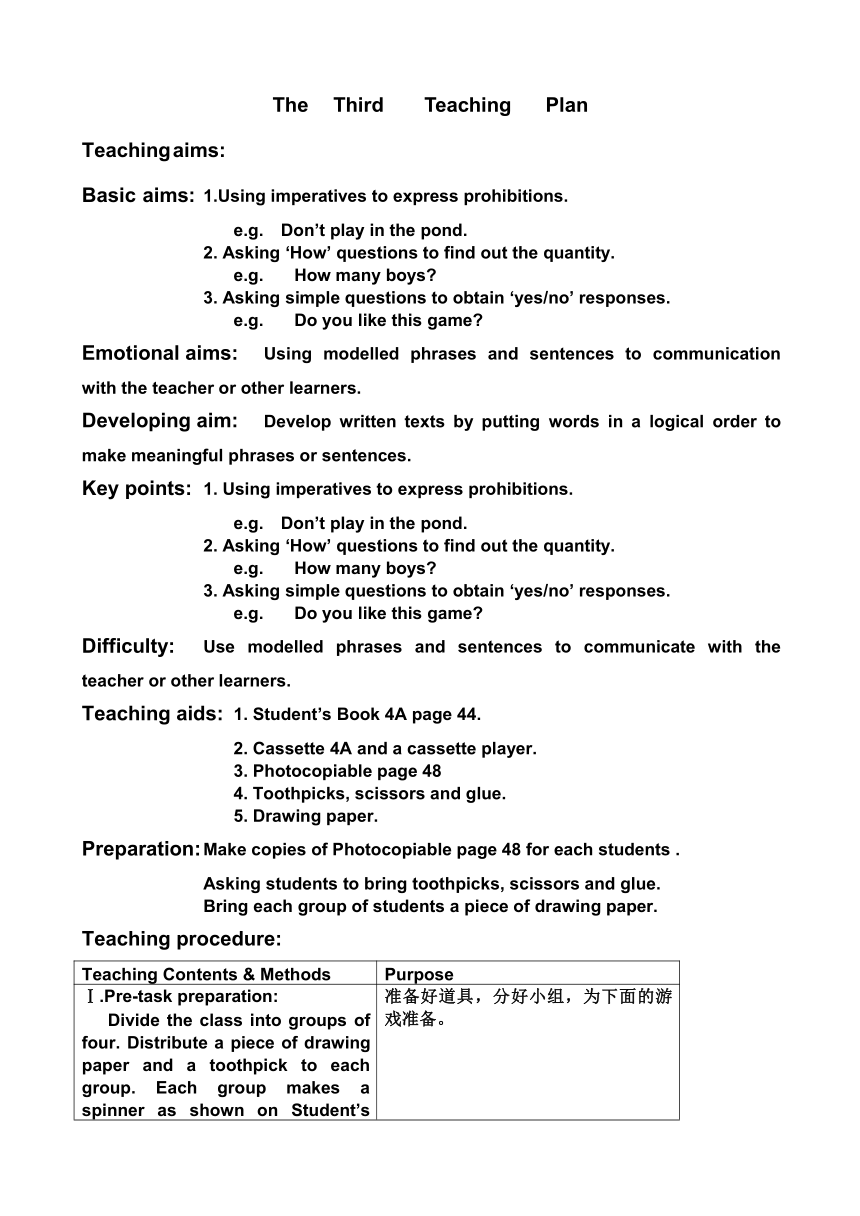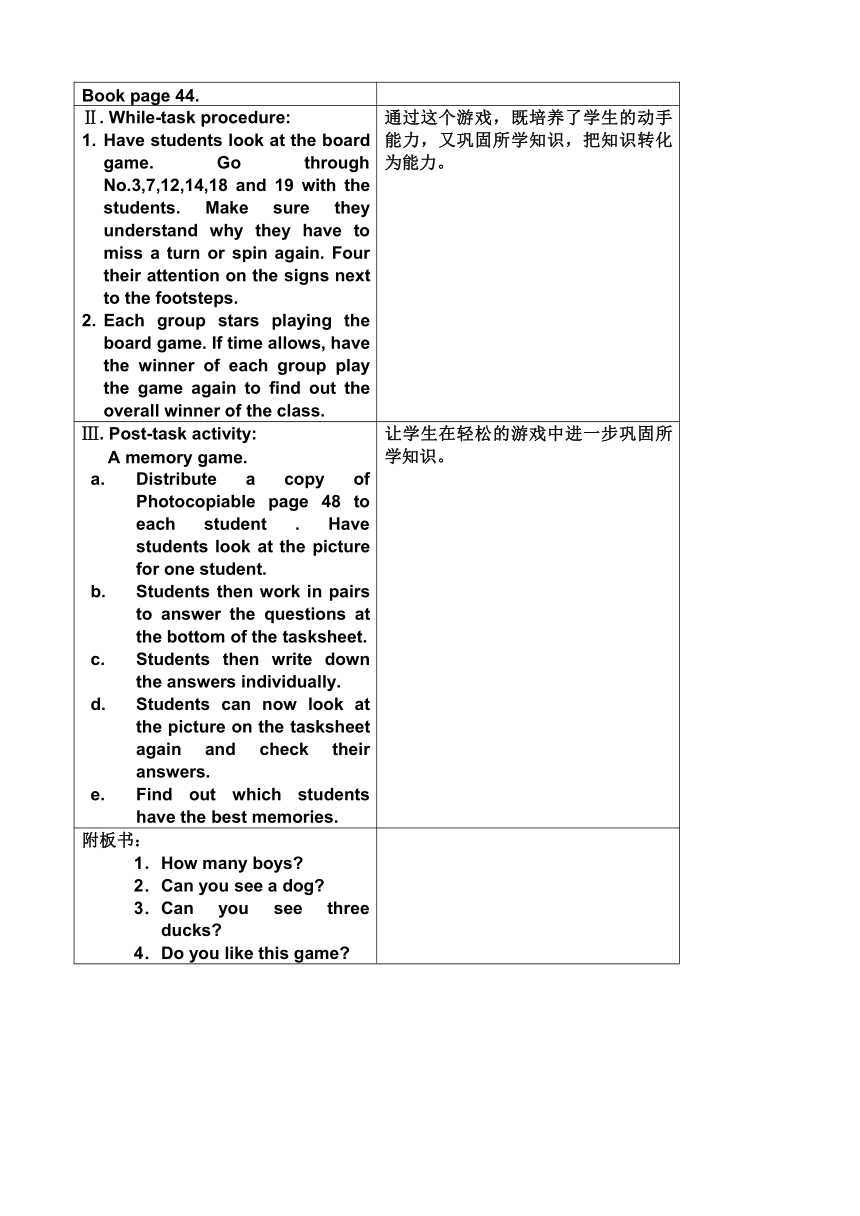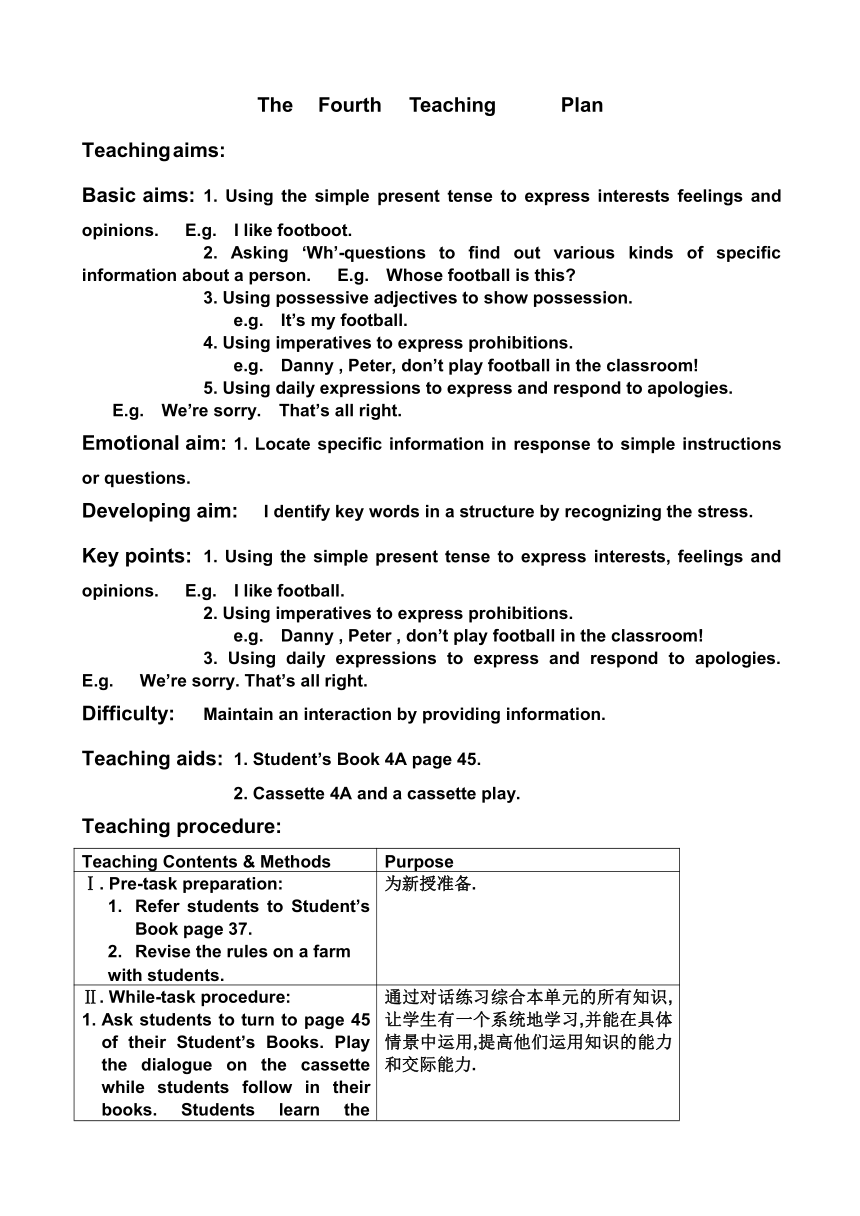沪教牛津版 4A modue4 uint3(3-4)课时 教案
文档属性
| 名称 | 沪教牛津版 4A modue4 uint3(3-4)课时 教案 |

|
|
| 格式 | zip | ||
| 文件大小 | 14.4KB | ||
| 资源类型 | 教案 | ||
| 版本资源 | 上海牛津(绿色上教版) | ||
| 科目 | 英语 | ||
| 更新时间 | 2012-09-24 17:16:23 | ||
图片预览



文档简介
The Third Teaching Plan
Teaching aims:
Basic aims: 1.Using imperatives to express prohibitions.
e.g. Don’t play in the pond.
2. Asking ‘How’ questions to find out the quantity.
e.g. How many boys
3. Asking simple questions to obtain ‘yes/no’ responses.
e.g. Do you like this game
Emotional aims: Using modelled phrases and sentences to communication with the teacher or other learners.
Developing aim: Develop written texts by putting words in a logical order to make meaningful phrases or sentences.
Key points: 1. Using imperatives to express prohibitions.
e.g. Don’t play in the pond.
2. Asking ‘How’ questions to find out the quantity.
e.g. How many boys
3. Asking simple questions to obtain ‘yes/no’ responses.
e.g. Do you like this game
Difficulty: Use modelled phrases and sentences to communicate with the teacher or other learners.
Teaching aids: 1. Student’s Book 4A page 44.
2. Cassette 4A and a cassette player.
3. Photocopiable page 48
4. Toothpicks, scissors and glue.
5. Drawing paper.
Preparation: Make copies of Photocopiable page 48 for each students .
Asking students to bring toothpicks, scissors and glue.
Bring each group of students a piece of drawing paper.
Teaching procedure:
Teaching Contents & Methods Purpose
Ⅰ.Pre-task preparation: Divide the class into groups of four. Distribute a piece of drawing paper and a toothpick to each group. Each group makes a spinner as shown on Student’s Book page 44. 准备好道具,分好小组,为下面的游戏准备。
Ⅱ. While-task procedure:Have students look at the board game. Go through No.3,7,12,14,18 and 19 with the students. Make sure they understand why they have to miss a turn or spin again. Four their attention on the signs next to the footsteps.Each group stars playing the board game. If time allows, have the winner of each group play the game again to find out the overall winner of the class. 通过这个游戏,既培养了学生的动手能力,又巩固所学知识,把知识转化为能力。
Ⅲ. Post-task activity: A memory game.Distribute a copy of Photocopiable page 48 to each student . Have students look at the picture for one student.Students then work in pairs to answer the questions at the bottom of the tasksheet.Students then write down the answers individually.Students can now look at the picture on the tasksheet again and check their answers.Find out which students have the best memories. 让学生在轻松的游戏中进一步巩固所学知识。
附板书:How many boys Can you see a dog Can you see three ducks Do you like this game
The Fourth Teaching Plan
Teaching aims:
Basic aims: 1. Using the simple present tense to express interests feelings and opinions. E.g. I like footboot.
2. Asking ‘Wh’-questions to find out various kinds of specific information about a person. E.g. Whose football is this
3. Using possessive adjectives to show possession.
e.g. It’s my football.
4. Using imperatives to express prohibitions.
e.g. Danny , Peter, don’t play football in the classroom!
5. Using daily expressions to express and respond to apologies. E.g. We’re sorry. That’s all right.
Emotional aim: 1. Locate specific information in response to simple instructions or questions.
Developing aim: I dentify key words in a structure by recognizing the stress.
Key points: 1. Using the simple present tense to express interests, feelings and opinions. E.g. I like football.
2. Using imperatives to express prohibitions.
e.g. Danny , Peter , don’t play football in the classroom!
3. Using daily expressions to express and respond to apologies. E.g. We’re sorry. That’s all right.
Difficulty: Maintain an interaction by providing information.
Teaching aids: 1. Student’s Book 4A page 45.
2. Cassette 4A and a cassette play.
Teaching procedure:
Teaching Contents & Methods Purpose
Ⅰ. Pre-task preparation:Refer students to Student’s Book page 37.Revise the rules on a farmwith students. 为新授准备.
Ⅱ. While-task procedure:Ask students to turn to page 45 of their Student’s Books. Play the dialogue on the cassette while students follow in their books. Students learn the content through listening.Ask individual students questions about the story .Play the cassette again. Students follow and repeat.Divide students into groups of three to act out the story.Select group to act the story to the class. For more able students, encourage them to made modified. 通过对话练习综合本单元的所有知识,让学生有一个系统地学习,并能在具体情景中运用,提高他们运用知识的能力和交际能力.
Ⅲ. Post-task activities Whose is/are this/these Teacher collects a pen from a more able student.Ask the student: Whose pen is this To elicit: This is my pen.Teacher points to the student and says to the rest of the class. This is his pen. The rest of the class repeat.Divide students into groups of three. Ask them to mime and practice the above procedures. Tell students that they can hold up one kind of stationery item(quantity less than twenty) only.Ask students to change roles until they all have played each role once. 巩固本单元的重点句型”Whose”句型,使学生能掌握牢固.
Ⅳ. Homework:Listen to the cassette. Read the dialogue for four times.Grammar Practice Book 4A page 39-40. 进一步巩固所学知识.
附板书: Say and act Don’t play football in the classroom!
Teaching aims:
Basic aims: 1.Using imperatives to express prohibitions.
e.g. Don’t play in the pond.
2. Asking ‘How’ questions to find out the quantity.
e.g. How many boys
3. Asking simple questions to obtain ‘yes/no’ responses.
e.g. Do you like this game
Emotional aims: Using modelled phrases and sentences to communication with the teacher or other learners.
Developing aim: Develop written texts by putting words in a logical order to make meaningful phrases or sentences.
Key points: 1. Using imperatives to express prohibitions.
e.g. Don’t play in the pond.
2. Asking ‘How’ questions to find out the quantity.
e.g. How many boys
3. Asking simple questions to obtain ‘yes/no’ responses.
e.g. Do you like this game
Difficulty: Use modelled phrases and sentences to communicate with the teacher or other learners.
Teaching aids: 1. Student’s Book 4A page 44.
2. Cassette 4A and a cassette player.
3. Photocopiable page 48
4. Toothpicks, scissors and glue.
5. Drawing paper.
Preparation: Make copies of Photocopiable page 48 for each students .
Asking students to bring toothpicks, scissors and glue.
Bring each group of students a piece of drawing paper.
Teaching procedure:
Teaching Contents & Methods Purpose
Ⅰ.Pre-task preparation: Divide the class into groups of four. Distribute a piece of drawing paper and a toothpick to each group. Each group makes a spinner as shown on Student’s Book page 44. 准备好道具,分好小组,为下面的游戏准备。
Ⅱ. While-task procedure:Have students look at the board game. Go through No.3,7,12,14,18 and 19 with the students. Make sure they understand why they have to miss a turn or spin again. Four their attention on the signs next to the footsteps.Each group stars playing the board game. If time allows, have the winner of each group play the game again to find out the overall winner of the class. 通过这个游戏,既培养了学生的动手能力,又巩固所学知识,把知识转化为能力。
Ⅲ. Post-task activity: A memory game.Distribute a copy of Photocopiable page 48 to each student . Have students look at the picture for one student.Students then work in pairs to answer the questions at the bottom of the tasksheet.Students then write down the answers individually.Students can now look at the picture on the tasksheet again and check their answers.Find out which students have the best memories. 让学生在轻松的游戏中进一步巩固所学知识。
附板书:How many boys Can you see a dog Can you see three ducks Do you like this game
The Fourth Teaching Plan
Teaching aims:
Basic aims: 1. Using the simple present tense to express interests feelings and opinions. E.g. I like footboot.
2. Asking ‘Wh’-questions to find out various kinds of specific information about a person. E.g. Whose football is this
3. Using possessive adjectives to show possession.
e.g. It’s my football.
4. Using imperatives to express prohibitions.
e.g. Danny , Peter, don’t play football in the classroom!
5. Using daily expressions to express and respond to apologies. E.g. We’re sorry. That’s all right.
Emotional aim: 1. Locate specific information in response to simple instructions or questions.
Developing aim: I dentify key words in a structure by recognizing the stress.
Key points: 1. Using the simple present tense to express interests, feelings and opinions. E.g. I like football.
2. Using imperatives to express prohibitions.
e.g. Danny , Peter , don’t play football in the classroom!
3. Using daily expressions to express and respond to apologies. E.g. We’re sorry. That’s all right.
Difficulty: Maintain an interaction by providing information.
Teaching aids: 1. Student’s Book 4A page 45.
2. Cassette 4A and a cassette play.
Teaching procedure:
Teaching Contents & Methods Purpose
Ⅰ. Pre-task preparation:Refer students to Student’s Book page 37.Revise the rules on a farmwith students. 为新授准备.
Ⅱ. While-task procedure:Ask students to turn to page 45 of their Student’s Books. Play the dialogue on the cassette while students follow in their books. Students learn the content through listening.Ask individual students questions about the story .Play the cassette again. Students follow and repeat.Divide students into groups of three to act out the story.Select group to act the story to the class. For more able students, encourage them to made modified. 通过对话练习综合本单元的所有知识,让学生有一个系统地学习,并能在具体情景中运用,提高他们运用知识的能力和交际能力.
Ⅲ. Post-task activities Whose is/are this/these Teacher collects a pen from a more able student.Ask the student: Whose pen is this To elicit: This is my pen.Teacher points to the student and says to the rest of the class. This is his pen. The rest of the class repeat.Divide students into groups of three. Ask them to mime and practice the above procedures. Tell students that they can hold up one kind of stationery item(quantity less than twenty) only.Ask students to change roles until they all have played each role once. 巩固本单元的重点句型”Whose”句型,使学生能掌握牢固.
Ⅳ. Homework:Listen to the cassette. Read the dialogue for four times.Grammar Practice Book 4A page 39-40. 进一步巩固所学知识.
附板书: Say and act Don’t play football in the classroom!
同课章节目录
- Module 1 Getting to know you
- Unit 1 Hello again
- Unit 2 How old are you?
- Unit 3 What are you?
- Module 2 Me,my family and friends
- Unit 1 A new classmate
- Unit 2 How do you feel?
- Unit 3 Friends
- Module 3 Places and activities
- Unit 1 in the school
- Unit 2 Food
- Unit 3 A class picnic
- Module 4 The natural world
- Unit 1 On the farm
- Unit 2 More insects and plants
- Unit 3 A day in the park
